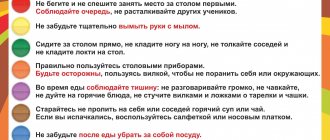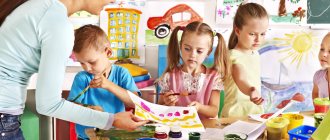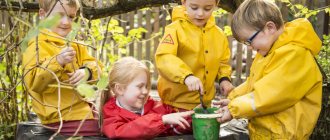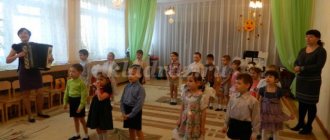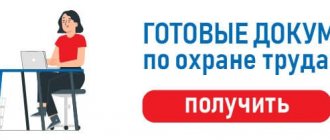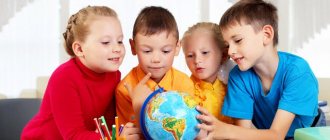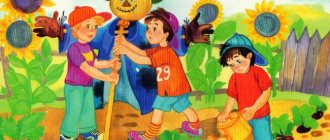Requirements for the daily routine in preschool educational institutions according to SanPiN
The standard daily routine in kindergarten is designed for 12 hours, which the child spends within the preschool walls. Any adjustments are made taking into account climatic conditions, geographical location, and other factors. The regime is drawn up in accordance with sanitary and epidemiological rules and regulations SanPiN 2.4.12660–10. Key points:
- The kindergarten provides four meals a day with a time interval of 4 hours between meals.
- There are 2 walks in the fresh air - in the morning and after a nap. In total, walking with children requires 3–4 hours. The time spent outside is reduced at temperatures below –15 °C and wind speeds of 7 m/s.
- According to the daily schedule, nap time is 2–2.5 hours, while the teacher must be present in the bedroom and monitor the sleeping children.
- It is required to ventilate the room for less than 10 minutes. every 90 minutes If there are no children, arrange ventilation 30 minutes in advance. before they arrive from the street or classes. The air temperature should not drop more than 2–4 °C; it is important to avoid drafts.
- Bed linen in kindergarten must be changed at least once a week (according to the schedule).
- In the cold season, the teacher should meet the children in the morning in the group, in warm weather - outside (at the group site).
Diet
| Time | Eating | Approximate menu |
| 8:30 | Breakfast | A hot dish (milk porridge, cottage cheese casserole, egg omelet), tea or cocoa, a sandwich with butter and cheese. |
| 10:00 | Lunch | Drink with or without fruit. |
| 12:00 | Dinner | First course (borscht, soup), second (side dish with meat or fish), salad or vegetables, cold drink. |
| 15:00 | Afternoon snack | Baking (bread), drink. |
| 18:00 | Dinner | Meat or fish dish, cottage cheese, drink. |
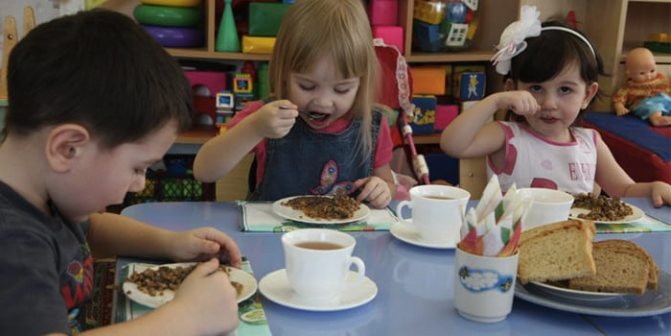
Kindergarten classes
In kindergarten, they develop speech skills, broaden their horizons, introduce them to the basics of mathematics and writing, instill a love of creativity and culture, and provide new knowledge. In the absence of medical contraindications, classes are conducted in the following areas:
- physical training;
- music, singing;
- art;
- mathematics;
- development of speech, logic, fine motor skills;
- preparation for school.
In kindergarten, independent games are held, when children communicate with peers, make friends, and relax. There are no more than 3 classes per day in kindergarten, with a break between them of at least 10 minutes. Lesson duration:
- junior group (children 3–4 years old) – 10 min.;
- middle group (4–5 years) – 15 minutes;
- senior group (5–6 years old) – 20 min.;
- preparatory group (6–7 years old) – 30 min.
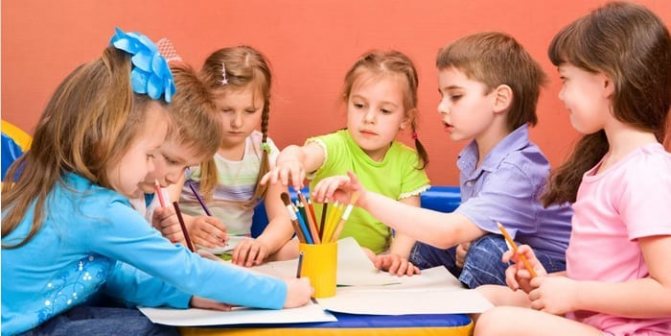
Features of the daily routine of children in early age groups article (younger group)
Features of the daily routine of children in early age groups
The most important condition for the proper development of children is a clear daily routine that corresponds to age and individual characteristics. Most teachers, physiologists, doctors (N.M. Shchelovanov, N.M. Aksarina, I.A. Arshavsky, N.M. Fonarev and others) define the regime as the basis of the life of a small child.
A regime is a rational distribution in time and the correct mutual sequence of satisfying the basic physiological needs of the child’s body (sleep, eating, wakefulness), as well as a change in activities.
Wakefulness is an active state of the cerebral cortex, which is supported by stimuli from the outside world (I.P. Pavlov).
Sleep is also an active process because many nerve cells are active during sleep. But the activity of the sense organs is inhibited at this time. Sleep occurs as a result of natural fatigue after a sufficient duration (in accordance with age) of wakefulness. The alternation of sleep and wakefulness is an important condition for normal human mental activity.
Proper organization of children's lifestyle is a necessary condition for the normal development of the nervous system. Taking into account the age characteristics of the child, the regime should provide for the presence of all elements of the child’s life (sleep, walk, activity, etc.), disciplining and promoting normal physical development.
Indicators of a properly designed regime are:
1. The child’s absence of negative emotions (crying, whims, negative reactions, etc.).
2. The baby's activity level is appropriate for his age.
3. The child calmly moves from one state to another (from wakefulness to sleep and vice versa), from one type of activity to another.
4. The child has a good appetite and deep sleep.
5. The child takes an active part in all routine processes and has a positive attitude towards them.
Leading teachers (N.M. Aksarina, G.M. Lyamina, M.Yu. Kistyakovskaya, etc.) formulated the basic methodological rules for conducting regime processes.
1. All routine processes should be aimed at timely and complete satisfaction of the organic needs of the child’s body. Adults' attention is focused on nurturing a child's positive attitude towards all routine processes (eating, hygiene procedures, activities, movements, going to bed, etc.). To do this, the adult’s requirements must always coincide with the child’s needs. An adult offers the child to eat when the baby is hungry, offers to sleep when he is tired, etc.
2. The child’s interest in the routine process increases if he takes an active part in it as much as possible. For example, at 10-11 months he holds a spoon and tries to scoop up food while eating, at 2 years he eats independently; at 1-6 months he takes off his socks, hat, etc. At 2-3 years old he tries to undress, dress, etc. on his own.
While actively participating in routine processes, a child may make mistakes and do things differently than the adult requires. Most often this happens due to the child’s lack of experience and knowledge. It is very important that an adult does not focus children’s attention on wrong actions, but teaches them how to do the right thing. For example, during feeding, the teacher noticed that the child took food from the plate not with a spoon, but with his hand. He approaches the child and quietly says: “Misha, take a spoon and eat. What a great fellow you are, you hold the spoon correctly.”
3. All routine processes must be used by adults to raise a child.
A child’s life passes in a constant alternation of sleep, wakefulness, and feeding. It is important to use all this for the development of the baby. For this purpose, it is necessary to discuss all the actions of an adult and a child, to name the properties of objects and phenomena. Form the necessary habits and behavioral skills. For example, during feeding, an adult not only forms rules of behavior for the child, but also enriches the vocabulary with the names of dishes and their qualities (sweet jelly, warm-hot milk, etc.).
4. The organization of a regime in a children's institution involves the gradual involvement of children in one or another regime process (the principle of gradualism). For example, when organizing feeding, the teacher offers 2-3 children to put away toys and wash their hands, after which the children sit at the table and are immediately served food, and at this time the other 2-3 children wash their hands and sit at the table, etc.
5. Before each regime process, the teacher gives instructions. For example: “We’ll have lunch soon. Seryozha, Masha, put the toys back and let’s go wash our hands.” The setting should be given a few minutes before the start of the regime process, so that children can switch to a new type of activity.
Physiological basis of daily routine
Sleep and wakefulness are two conjugate states. The nature of falling asleep, the depth and duration of sleep depend on how active the child was while awake. If a child has slept well, then his wakefulness, as a rule, is active.
The regime should provide the daily amount of sleep and wakefulness. For children attending a childcare center, a regime is drawn up not only for the duration of the child’s stay in kindergarten, but also for the home, i.e. for a day.
If a child is put to bed, fed, and kept awake at the same time, then he develops a system of conditioned reflexes at the time of eating, going to bed, and vigorous activity.
This system of conditioned reflexes for time, which I.P. Pavlov called a dynamic stereotype, constitutes the physiological basis of the regime. The existing dynamic stereotype prepares the body in advance for eating at a certain time, sleep, and vigorous activity, and thereby saves the child’s nervous energy.
The child's wakefulness is associated with active activity - excitation of nerve cells under the influence of external stimuli entering the cerebral cortex through the corresponding receptors (eye, ear, skin, etc.). The central nervous system of a child of early and preschool age is still weak, and during wakefulness he gets tired easily.
When drawing up a regimen, the operating capacity limit of the child’s nervous system is taken as a basis, which, for example, changes many times during early childhood. The performance limit of the nervous system at different age periods determines the duration of wakefulness, the amount of daytime and night sleep. Properly organized and sufficiently long sleep is of great importance for restoring the normal state of nerve cells. During sleep, the child should fully regain his strength. And for this, sleep must be complete and deep. And this must be taken into account in children's institutions.
Pedagogical and hygienic significance of the daily routine
Following a daily routine allows you to solve many pedagogical problems.
The development and education of personality in preschool age occurs in the so-called “everyday” activities: in various routine moments (washing, feeding, dressing and undressing).
By creating conditions for this activity and communicating with the child, the teacher solves a number of problems:
- education of independence as relative independence from an adult (its prerequisite is the formation of elementary instrumental actions on an emotional and visual basis);
- accumulation of experience of independent actions in everyday processes contributes to the development of self-respect and self-esteem. Through actions with household items (towel, soap, dishes, items of clothing and shoes, etc.), the foundations of a future work culture and frugality are laid;
— education of neatness skills, food culture, which is usually called cultural and hygienic skills. They protect the child’s health and are associated with the upbringing of his general culture;
- fostering a friendly attitude towards each other, since in a kindergarten, when performing self-service processes, many situations arise that require personal and “business” contacts from children.
It is important for the teacher to create certain conditions for the successful solution of the above problems. The entire environment for performing household processes must be adapted to the growth of the child. All items and equipment for basic work activities (oilcloth, aprons, mittens, rags, etc.) must have a specific storage location that the children know. All this will contribute to the independence of children.
The child’s participation in all processes must be accompanied by positive emotions, otherwise the child becomes immune to pedagogical influences. Therefore, it is important that the water for washing is warm and the tap is at such a level that water does not flow into the sleeve; soap - of such a size that a child can hold it in his still very inept hands; the food utensils attracted attention with their appearance, etc.
All regime moments should be thought out from the point of view of the gradual inclusion of children in the process (individually or in groups of 2-3 people) in order to ensure an individual approach to children as much as possible. It is important to take into account that there are children who are slow or, conversely, active, and the teacher must provide each child with the time necessary for independent actions.
Of great importance in solving educational problems are game techniques for encouraging correct actions, exercises in actions on special material (for example, frames with fasteners, buttons, snaps, laces, etc.).
The mental and personal development of children occurs not only in everyday activities organized in routine processes, but also in the conditions of learning in the classroom.
Classes are the main, most effective form of teaching children. Classes ensure the targeted development of the child, as they are conducted in accordance with the program, taking into account their individual development. In classes under the guidance of a teacher, children acquire knowledge about the life around them, skills and abilities. They develop all mental processes: perception, memory, attention, thinking, speech. Already at an early age, children acquire basic learning skills in classes. They learn to listen carefully to the teacher, perceive the task, and act in accordance with it. During the classes, children acquire some knowledge and life skills in a children's community (not to disturb each other, work with their own toy, wait while an adult is working with another child, etc.).
The children's interest in the lesson is supported by the emotional attitude of the teacher to what he shows and talks about. An adult’s emotional attitude to an activity is most often expressed through facial expressions and speech. It is important to change intonation and use it to highlight the main thing that the teacher wants to draw the children’s attention to. The teacher’s speech should be understandable to children, clear, literate, and the phrases should be short. Where necessary, the teacher uses artistic expression.
The objects and aids that the teacher uses in the lesson play a big role when conducting classes with children. They should be bright, attractive, and arouse children's interest. But it is not enough for children to just see an object. They always have a desire to touch it, examine it, act with it. That is why, for example, at an early age, the leading method of teaching is visual and effective. When using this method, children have the opportunity not only to watch, listen, but also to act with the object, answer questions, i.e. show activity, independence, and an emotional attitude to the subject.
When organizing classes with children, the teacher must remember that the more analyzers (visual, tactile, auditory, motor) are involved in perception and the more active the child, the deeper the impression and the stronger the memory, and therefore the higher the learning effect of the lesson.
The hygienic importance of the daily routine lies in the proper organization of sleep, diet, and wakefulness.
So, the hygienic organization of sleep is as follows. Before going to bed, you cannot feed your child plenty of tea, coffee, cocoa, outdoor games are unacceptable, because as a result, the child cannot fall asleep immediately, and as a result does not get enough sleep. To help children fall asleep quickly and sleep well, it is recommended to put them to bed at the same time. The speech of adults should be gentle, quiet, movements soft and calm. Each child should have his own crib. You cannot rock a child to sleep or sing songs to him, because... this may become a habit, without which he will not be able to fall asleep quickly. In the room where children sleep, the windows and transoms should be open, but they are closed 20-30 minutes before the children get up. During sleep, the child should be in a state of thermal comfort. It is very important to choose comfortable and warm clothes for him to sleep in accordance with the time of year.
Light and loud conversations are not allowed during sleep. A child should not sleep with his head covered in a blanket, on his stomach or buried in a pillow. It is harmful for children to lie in the same position all the time; this can lead to deformation of the skull, chest, and spine. Parents should also know these rules.
For the proper development of a child, a rational diet is necessary. Children should eat at exactly the right time. It is important that the child does not receive breakfast when leaving for kindergarten, otherwise he will refuse it in kindergarten and thereby disrupt his diet.
Decreased appetite (anorexia) is a common occurrence in children, especially young children. This occurs as a result of feeding the child against his desire or under the influence of any irritants (burn of the mouth, too hot food, harsh remarks from adults during feeding, etc.). More often, this is observed in children with a weakened nervous system during the period of adaptation to a preschool institution. Therefore, it is necessary to create a calm, friendly environment during meals, keep children in a good mood, do not scold the child if he eats slowly, and do not make frequent comments to him.
When organizing wakefulness, it is also necessary to take into account hygienic requirements. Children who are captivated by an interesting game do not feel tired, but improperly structured activities can be a strain on the child’s nervous system and quickly lead to fatigue.
The nervous system of young children is characterized by weak endurance and rapid fatigue. Therefore, for example, classes in early age groups should not exceed 5-10 minutes in the 2nd year of life and 5-20 minutes in the 3rd year. And during the lesson, it is necessary to monitor the condition of the children and at the first signs of fatigue (motor restlessness, inappropriate responses, distraction, redness or paleness of the skin, slight coughing, etc.), the teacher must take measures: change the position of the children, arouse interest with using surprise moments, giving a motor task, etc. If these measures do not help, then it is better to stop the activity. Under no circumstances should children be forced to study.
It is important to think carefully about the alternation of activities. Games that require significant mental effort should be followed by outdoor games that do not require great mental effort.
Activities need to be organized so that they vary in complexity. For example, it is impossible to conduct physical education and modeling classes on the same day, because for physical education, children must change clothes, and modeling requires washing hands, cleaning tables, etc. When classes are organized in this way, children become overexcited, tired, and their mood and well-being worsen.
Physical exercise and walks in the fresh air should definitely be included in the daily routine, especially in the summer. In winter, it is recommended to walk with children at least 2 times a day at specially designated times. Walking has a beneficial effect on the nervous system, improves appetite, sleep, mood, trains the cardiovascular system, and is one of the means of hardening.
Physical exercise plays a huge role in the formation of a child’s body. They promote the development of all organs and systems: the motor system, coordination of movements, increase muscle excitability, pace, strength, general endurance, cause increased cardiac activity, on the work of which the supply of the entire body with oxygen and nutrients depends.
Daily routine in kindergarten
The daily routine in kindergarten depends on the age of the child, the specialization of the preschool educational institution, and other factors at the discretion of the teacher (methodologist, management). Activities that require increased mental stress for children are carried out in the first half of the day, alternating with physical education, music, and fine arts. This is important in order not to overload the child, to make him a comprehensively developed personality to the delight of dad and mom.
Nursery group (2–3 years)
It is important to follow the daily routine in kindergarten from the nursery on. This is necessary so that the kids adapt faster. It is important to speed up the process of getting used to the teachers and nanny so that the child does not worry and goes to kindergarten with joy every morning. Approximate daily schedule:
| Time | Daily regime |
| 7:00–8:00 | Reception of babies |
| 8:00–8:20 | Breakfast |
| 8:20–9:00 | Independent games in a group |
| 9:00–9:30 | Preparing for the walk |
| 9:30–11:30 | Street games |
| 11:30–11:45 | Return to the group, preparation for lunch |
| 11:45–12:15 | Dinner |
| 12:15–12:30 | Preparation for sleep |
| 12:30–15:00 | Quiet hour |
| 15:00–15:15 | Waking up after a nap |
| 15:15–15:30 | Afternoon snack |
| 15:30–15:45 | Stand alone games |
| 15:45–16:15 | Group classes |
| 16:15–16:30 | Preparing to go outside |
| 16:30–18:00 | Walk |
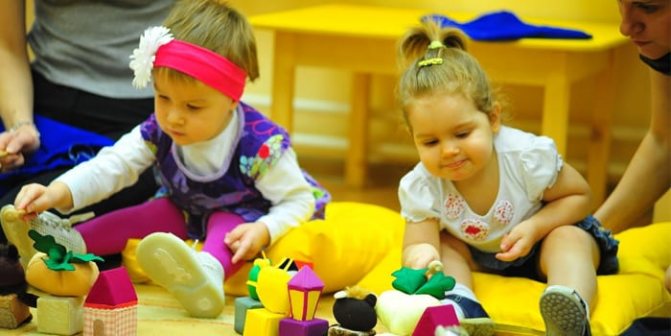
Junior group (3–4 years old)
| Time | Daily regime |
| 7:00–8:20 | Reception of children, morning exercises, games |
| 8:20–8:50 | Preparing for breakfast, eating |
| 8:50–9:20 | Games, preparation for classes |
| 9:20–10:00 | Classes |
| 10:00–10:20 | Preparing for the walk |
| 10:20–12:20 | Outdoor recreation |
| 12:20–13:00 | Dinner |
| 13:00–15:15 | Quiet hour |
| 15:15–15:45 | Awakening, games, air procedures |
| 15:45–16:00 | Afternoon snack |
| 16:00–16:30 | Games, physical activity |
| 16:30–16:50 | Gathering outside |
| 17:00–18:00 | Walk |
Middle group (4–5 years old)
| Time | Daily regime |
| 7:00–8:20 | Reception of pupils, gymnastics, outdoor games |
| 8:20–8:50 | Preparing for breakfast, eating |
| 8:50–9:50 | Preparation for classes, classes |
| 9:50–11:50 | Gathering outside for a walk |
| 11:50–12:15 | Return to the group, preparation for lunch |
| 12:15–12:50 | Dinner |
| 12:50–13:00 | Preparing for sleep |
| 13:00–15:00 | Quiet hour |
| 15:00–15:25 | Awakening, games, air procedures |
| 15:25–15:50 | Afternoon snack |
| 15:50–16:30 | Games, physical activity, music lessons, educational program |
| 16:30–18:00 | Gathering outside for a walk |
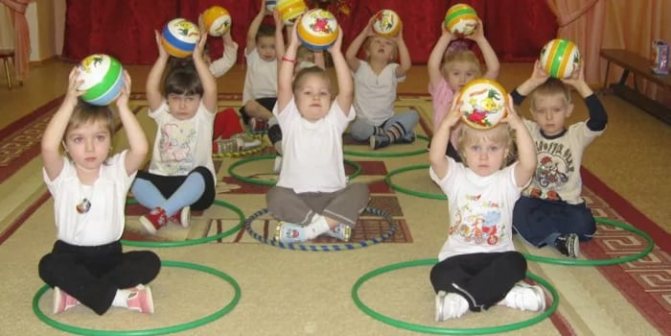
Senior (5–6 years old)
| Time | Daily regime |
| 7:00–8:30 | Reception of pupils, duty, gymnastics, outdoor games |
| 8:30–8:55 | Preparing for breakfast, eating |
| 8:55–10:50 | Developmental activities |
| 10:50–12:25 | Preparing for a walk, walk |
| 12:25–12:40 | Returning from the street, preparing for lunch |
| 12:40–13:15 | Dinner |
| 13:15–15:00 | Getting ready for bed, quiet time |
| 15:00–15:25 | Waking up, personal hygiene procedures |
| 15:25–15:40 | Afternoon snack |
| 15:40–16:20 | Games, physical education, labor, fine arts |
| 16:30–18:00 | Outdoor recreation |
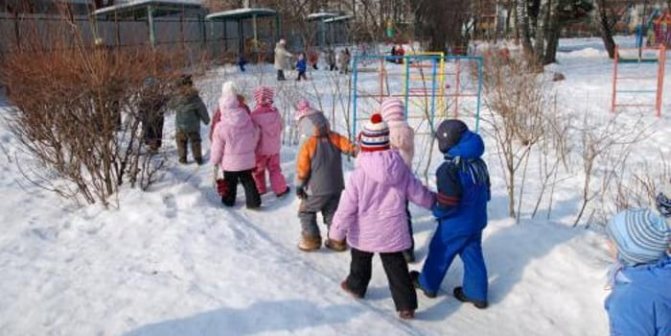
Preparatory group (6–7 years old)
| Time | Daily regime |
| 7:00–8:30 | Reception of pupils, duty, gymnastics, outdoor games |
| 8:30–8:50 | Preparing for breakfast, eating |
| 8:50–9:00 | Getting ready for classes |
| 9:00–11:05 | Preparing a preschooler for school |
| 11:05–12:35 | Gathering for a walk, walk |
| 12:35–12:45 | Return to the group |
| 12:45–13:15 | Dinner |
| 13:15–15:00 | Quiet hour |
| 15:00–15:25 | Waking up, maintaining personal hygiene |
| 15:25–15:40 | Afternoon snack |
| 15:40–16:30 | Games, work, fine arts, communication with peers, gathering outside |
| 16:30–18:00 | Outdoor recreation |
